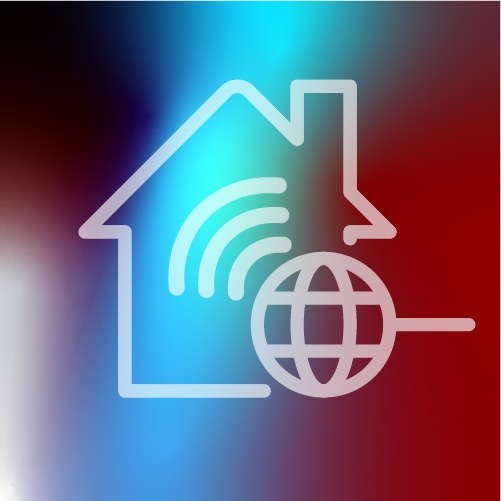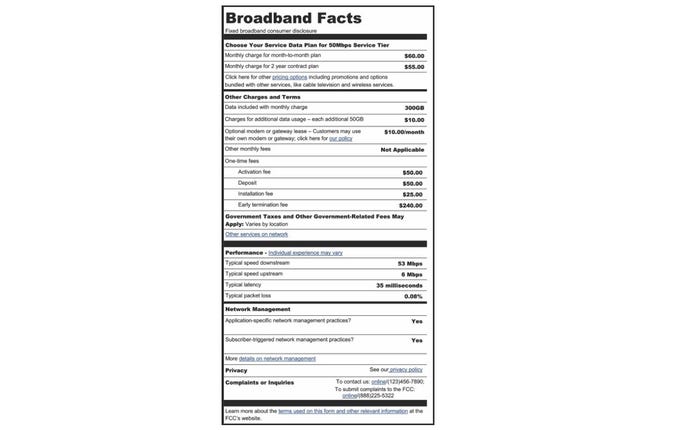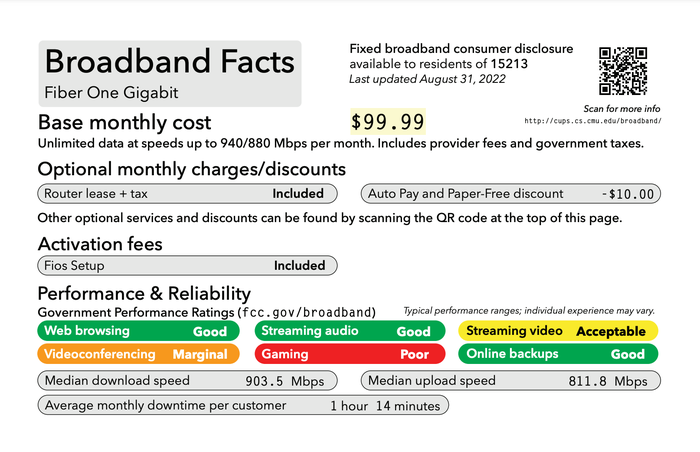Consumers want reliability info on broadband labels – study
In new research from Carnegie Mellon University, consumers indicated support for broadband labels but wanted more clarity on service speeds, reliability and costs.

A new study from Carnegie Mellon University's CyLab offers some insight into what consumers want from the FCC's forthcoming broadband nutrition labels. In addition to metrics previously proposed by the Commission, consumers indicated wanting speed data for "poor" and "normal" performance times, clarity on costs, and service reliability data.
The study, which surveyed 2,500 participants, is part of an effort to help inform the FCC's rulemaking process for broadband labels. The Commission was mandated by the Biden administration's infrastructure law to devise a process for creating broadband nutrition labels that will help consumers comparison shop for Internet service. (This follows a previously abandoned effort in 2016 to roll out labels on a voluntary basis.) The FCC began soliciting public input on the matter in January 2022.
Overall, CyLab found that study participants "strongly supported" the idea of broadband labels, with the most important information being cost, speed and reliability. On performance, consumers said they wanted additional details, including "how much the listed performance metrics could drop during peak times." That would be a departure from the 2016 label (pictured below), which lists "typical" performance metrics, including speed, latency and packet loss.
Figure 2:  (Source: FCC)
(Source: FCC)
CyLab also found that respondents struggled to comprehend some information on the 2016 version of the broadband labels, including total cost for service – noting "participants further expressed their desire to know the total cost of their Internet plan without any ambiguity" – and technical terms such as latency, packet loss, network management practices, performance percentiles and network congestion, which CyLab said should be defined.
Other details survey participants wanted were providers' privacy practices, equipment options and customer feedback, said CyLab.
After collecting feedback on the 2016 label, CyLab presented survey respondents with its own version of a broadband label. That label "performed better," according to the researchers.
"Consumers appreciated having access to more detailed information and found the new labels easier to use and comprehend," said CyLab.
The researchers then tweaked their label based on respondent feedback to come up with a format CyLab is now recommending to the FCC, including a summary version (pictured below) and a detailed version linked here.
Figure 1:  (Source: CyLab. Used with permission.)
(Source: CyLab. Used with permission.)
In addition to its recommendations for what data to include, CyLab further urged the FCC to require data in a machine-readable format that can be publicly hosted for third parties to offer consumers comparison tools. "We would love to see a website where consumers enter their zip code, some information about the number of people in their household, and the types of Internet services they use, and in turn get a plan comparison tailored to their needs," said Lorrie Cranor, director at CyLab.
'Beyond the scope'
How many of these recommendations make it into the new labels remains to be seen. In thousands of pages of industry filings, broadband providers have largely sought to adhere to the rules of the 2016 label.
In a recent ex parte filing, the trade association ACA Connects reiterated its request that the FCC stick to the performance metrics used in 2016. "More prescriptive performance measurement reporting requirements are beyond the scope of this proceeding, would impose tremendous burdens on smaller providers, and are unnecessary to protect consumers," reads the filing.
On machine readability, the association added: "Broadband labels are not amenable to machine readability given that the information they contain may not be entirely reducible to a set of standard fields that are the same for all providers and offerings ... Smaller providers with limited resources are likely to be disproportionately burdened by extraneous requirements such as machine-readability that go beyond the essential purpose of broadband labels as a consumer shopping tool."
Another industry group, NCTA–The Internet and Television Association, similarly told the FCC this summer that "the general content and format of the 2016 labels, with minor modifications, should serve as the model for the required labels, consistent with congressional intent."
The FCC is required by the broadband provision in the Biden administration's infrastructure law to adopt regulations for a consumer-friendly broadband label within a year of that law's passage, or by November 2022.
Related posts:
— Nicole Ferraro, editor, Light Reading, and host of "The Divide" podcast.
About the Author(s)
You May Also Like












